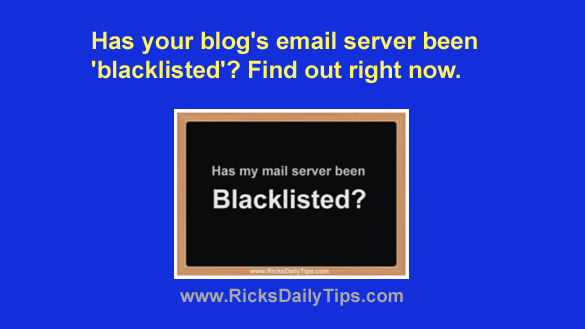 If you’re a blogger you probably depend on email to communicate with your readers, your advertisers and any other folks that you talk to in the course of writing and managing your blog.
If you’re a blogger you probably depend on email to communicate with your readers, your advertisers and any other folks that you talk to in the course of writing and managing your blog.
And chances are you even use email to deliver an informational newsletter to your subscribers.
If you’ve noticed that many (or even most) of your emails are being ignored, there’s a good chance that your email server has somehow landed in an email blacklist database.
In a nutshell, an email blacklist is simply an Internet database containing the IP addresses of email servers that have been reported for delivering SPAM or some other real or perceived transgression. I say “real or perceived” because it’s quite easy to end up on one or more blacklists when you have actually done nothing wrong.
In this post I’ll explain how to check to see if your email server is listed in roughly 100 of the most-used email blacklist databases, as well as what to do if you discover that it has indeed been blacklisted.
First, lets check to see if your mail server is on one or more blacklists. Just follow the steps below:
1 – Click here to launch the MX Toolbox Blacklist Checker tool in your web browser.
2 – If you know the IP address of your mail server, type (or copy and paste) it in to the box, then click the button labeled Blacklist Check.
If you don’t know your mail server’s IP address, simply enter your blog’s domain name and then click the Blacklist Check button. For example, if I wanted to check the mail server for this blog I would enter ricksdailytips.com.
After you have entered the IP address or domain name and clicked the Blacklist Check button you’ll be presented with a list of blacklist databases along with the result of the check for each database.
Now lets analyze the results to see if your mail server is listed in any of the blacklist databases…
If you see a green circle with a check mark beside the word “OK” that means your mail server isn’t blacklisted by that particular database.
If you see both a check mark and the word OK beside each and every one of the databases in the list, that means your mail server is in the clear and your emails should be making it at least to the mail servers that handle your recipients’ inbound and outbound email (usually their ISPs or web-based email providers such as Gmail).
If any of the blacklist databases have your mail server flagged as being blacklisted you can contact that service (or services) and ask to have your server removed from their database (i.e. un-blacklisted).
Simply Google the names of any services that have blacklisted your mail server and contact them via the email address or form listed on their websites. You’ll probably have to plead your case as to why the blacklist status should be removed, but there’s a good chance you’ll be successful.
Bottom line: If your email server has somehow found its way into a blacklist database, at least some of your emails could be ending up in a black hole somewhere. Obviously, that’s a bad thing.
The good news is you have a pretty good chance at having your blacklisted server removed if you dispute it with the affected blacklist service provider(s).